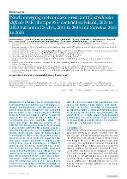Newly emerging metronidazole-resistant Clostridioides difficile PCR ribotype 955 identified in Poland, 2021 to 2023 but not in Czechia, 2012 to 2023 and Slovakia, 2015 to 2023

Author
Zíková, Jaroslava
Szarek, Klaudia
Kabała, Monika
Wultańska, Dorota
Frankowska, Natalia
Iwanicki, Adam
Hinc, Krzysztof
Mucha, Anna
Komarnicka, Jolanta
Jagielska, Anna
Kuijper, Ed
Pituch, Hanna
Publication date
2025Published in
EurosurveillanceVolume / Issue
30 (21)ISBN / ISSN
ISSN: 1025-496XISBN / ISSN
eISSN: 1560-7917Metadata
Show full item recordCollections
This publication has a published version with DOI 10.2807/1560-7917.ES.2025.30.21.2400675
Abstract
BackgroundOn 29 January 2024, the European Centre for Disease Prevention and Control distributed an alert about a metronidazole-resistant Clostridioides difficile outbreak of PCR ribotype (RT) 955 in England.AimWe aimed to investigate the presence of RT955 in Czech, Slovak and Polish C. difficile isolates and evaluate different culture media for detecting its metronidazole resistance.MethodsIsolates with binary toxin genes identified as 'unknown' by the WEBRIBO PCR ribotyping database up to 2023 were re-analysed after adding the RT955 profile to the database. The RT955 isolates were characterised by whole genome sequencing and tested for susceptibility to 15 antimicrobials.ResultsWe did not find RT955 in Czech (n = 6,661, 2012-2023) and Slovak (n = 776, 2015-2023) isolates, but identified 13 RT955 cases (n = 303, 2021-2023) in three hospitals in Poland. By whole genome multilocus sequence typing, 10 isolates clustered into one clonal complex including a sequence of United Kingdom strain ERR12670107, and shared similar antimicrobial resistance genes/mutations. All 13 isolates were resistant to ciprofloxacin/moxifloxacin, erythromycin/clindamycin and ceftazidime. All isolates had a mutation in the nimB gene promoter and in NimB (Tyr130Ser and Leu155Ile). The metronidazole resistance was detected in all isolates using brain-heart-infusion agar supplemented with haemin and Chocolate agar. Results were discrepant with the European Committee on Antimicrobial Susceptibility Testing-recommended Fastidious anaerobe agar and Brucella blood agar.ConclusionThe identification of clonally related haem-dependent metronidazole-resistant C. difficile RT955 in multiple hospitals indicates a need for prospective surveillance to estimate its prevalence in Europe.
Keywords
Clostridioides difficile, PCR ribotype 955
Permanent link
https://hdl.handle.net/20.500.14178/3102License
Full text of this result is licensed under: Creative Commons Uveďte původ 4.0 International







